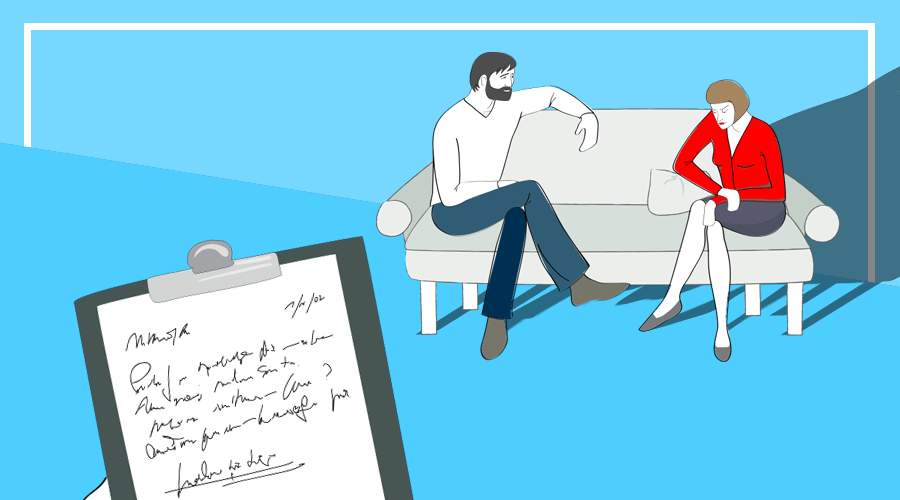A new study has found there’s actually something men can do to help alleviate a lady partner’s PMS, and it doesn’t involve decamping to the spare bedroom. It does involve, however, doing more talking. Don’t stop reading yet! We need you!
The study, published in the journal PLoS ONE by Jane Ussher, a professor of women’s health psychology in the Centre for Health Research at Western Sydney University, notes that about 40 percent of women report moderate to severe premenstrual symptoms. Such symptoms can contribute to fighting and tension in relationships — not to mention caricatures of women as chocolate-craving bitch-cakes moaning on the couch — but they found those symptoms could be reduced greatly with… wait for it… counseling.
Previous research, the authors note, has found that individual counseling for women to help them understand their own symptoms and how to best administer a little self-care can work well, as can taking antidepressants. But this study found that doing that counseling with a male partner is even better in reducing symptoms and improving the relationship.
This is because, traditionally, men say they don’t really get what’s going on with PMS. They may want to help but not know what to do [lays Midol on the coffee table; backs away slowly], or choose to get the hell out of dodge until the heat dies down. This, of course, only makes things worse: Women feel like two-headed gargoyles raging through the night with nobody to rub their feet and queue up a Merchant Ivory flick. (I prefer a French Vogue and a face mask.)
And it’s not exactly men’s fault for not getting it: PMS is poorly understood, not only by the women who experience it every month for decades of their lives, but also by science, which has declared the irritability, sadness and spectacular bitchiness alternately a mental disorder, a very effective way of weeding out men who won’t be impregnating you, or an entirely cultural phenomenon.
That last one is important here, because what it means is not that women don’t experience period-related horrors—the pain, menstrual cramps, fatigue, water retention and overall shittiness are documented, it’s just that in other countries that are not America, like China and India — places that, critically, treat periods like a normal natural thing that happens and not the time of month when a lady goes Gorgon — women don’t report the disturbed mood part (though they do experience other symptoms).
In other words, we make it worse by acting like it’s not real. Over at The Atlantic, James Hamblin interviewed Sarah Romans, a medical researcher out of the University of Toronto, to find out why. Romans and colleagues reviewed all the existing medical literature trying to link PMS to biology and found it dubious at best — sometimes the link was there, but sometimes not at all. Romans thinks it’s not that the symptoms aren’t real. We are just attributing them to the wrong factors — reproductive factors, instead of cultural, social or economic ones.
“I think this can be seen as the modern-day equivalent of the old ‘wandering womb’ notion,” Romans told Hamblin. “That women are hysterical because of their reproductive system. And when a woman’s upset, it’s still often one of the first thoughts people have — maybe she’s premenstrual — rather than ‘Is her physical health bad? Is she under a lot of stress? Is she lacking social support?’”
Instead, we treat the menstruating woman like a she-beast to be tiptoed around, avoided or mocked. Maybe that would be funny (no it wouldn’t) if it weren’t used historically to keep women out of actual jobs (pilots, physicians or presidents).
But consider that lesbian relationships, where there is greater premenstrual support from a lady partner who at least knows what a bad period feels like, the researchers note, “are associated with reduced symptoms and improved coping. Male partners who are supportive can have a similar positive effect.” That support could take many forms, but it’s worth noting that some women are actually really really horny on their periods, and period sex also relieves PMS symptoms and cramps. Coincidence?
Back to the study: The researchers followed 83 women (95 percent of whom were in hetero relationships) who tried a few variations on therapy over the course of three years: one-on-one counseling, couples therapy and a waiting list for therapy. Any woman who did therapy reported lower distress, less “overreacting” emotionally and literally fewer premenstrual symptoms. The researchers write:
However, the women in the couples-therapy group had significantly better behavioral coping strategies than those in the one-on-one therapy and wait-list control groups. In the couples-therapy group, 58 per cent of women reported increased self-care and coping. This compared to 26 per cent in the one-on-one, and 9 per cent in the wait-list group.
Most women in the couples-therapy group (57 per cent) reported an improved relationship with their partner. This was compared with 26 per cent in the one-on-one therapy group and 5 per cent of the wait-list reporting improvement.
In the couples-therapy group, 84 per cent of women reported increased partner awareness and understanding of PMS, compared with 39 per cent in the one-on-one therapy group and 19 per cent in the wait-list group.
In essence, more talking helped these women be better at talking, and as a result, they were less likely to lose their shit when they did all that talking. Men, too, were more inclined to talk better, and do the right things, and that allows any willing couple to head this whole PMS thing off at the pass. That may not sound like a walk in the park, but compared to the alternative, it should be reason enough to try.

